Fish Can’t Read – but I’m not so sure
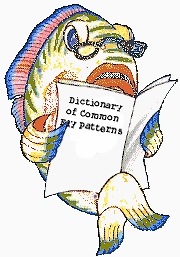 Fish Can’t Read is the latest in a burgeoning trend of online fly fishing magazines promising to be less trite than traditional angling fare.
Fish Can’t Read is the latest in a burgeoning trend of online fly fishing magazines promising to be less trite than traditional angling fare.
No expense was spared in sweeping together an eclectic mix of caustic, opinionated burnouts – fresh-faced youth, all buttressed by vast expanses of partially clad salmonids; swathed in the warm colors of mountainous sunsets, the rich sepia of near dark, and clouds of bloodsucking insects.
It’s well documented that big fish can read, albeit lacking full command of the language, they’ve assembled a rudimentary understanding of local signage – allowing them to exploit “No Trespassing” and “No Fishing” with great impunity.
Brought to you by the lads from Dry Fly Media, first issue to debut August/September 2009.
Got content? Submissions are encouraged – part of the agility that is the online canvas…
Cartography be damned
Should make some feel less conspicuous, although ordering one in a logger bar – you hope your voice doesn’t break mid sentence…

Its got a rarified pedigree, being made from glacier ice that crumbles off the continental shelf due to climate change, which makes the bottle bobbing in your wake testament to your domination of the watershed – scourge of the pristine…
Can’t say as I didn’t earn it
 The real piece of good fortune was coming down with the flu on the eve of the angling departure, rather than during – as none of my pals would have noticed anything amiss.
The real piece of good fortune was coming down with the flu on the eve of the angling departure, rather than during – as none of my pals would have noticed anything amiss.
Maybe they’d scratch their chin when I failed to acknowledge dinner, or didn’t protest when they divided up my dry flies among themselves. If there were any signs of life from my flaccid and feverish bedroll – they’d say, “he smelled bad before the trip, Ma’am -how was we to know he wasn’t simply funning us?”
The Bad News is I lived up to my promise, spending the last four days in a cataclysmic meltdown that has me in the same clothing, absent cigars, and strong coffee – and facing early demise as She (formerly banished as it was a guy only fishing trip) is racing to my door to put an end to my sufferings…
… with a large can of Woop-ass.
There will be no Angels of Mercy daubing my feverish cheeks on the morrow, no fluffing of too-soft pillows, no replenishing of the Sacred Baked Goods, there will only be those gals already angry – and those speechless in fury at the state of Her house.
I’ll be Jimmy Stewart in Hitchcock’s Rear Window – helpless and struggling from my wheelchair – as (Ms.) Raymond Burr attempts to unscrew my head like a champagne cork before setting the garden hose on whatever stayed attached.
How Yugoslavia put the adrenaline back in fly tying
I suppose some might consider it “the fun’s back in fly tying” – but while I’m here sucking a forefinger, I don’t see it that way…
The Skalka and Knapek competition barbless hooks arrived yesterday, and with less than 24 hours before my march northward, I had to bang out as many flies as possible to have something to test.
I tested my coagulation rate thoroughly, that and my blood type…
Knapek dry fly and streamer hooks are a “squarish” bend with a wicked kirbed, barbless needle for a point that seeks human flesh with neither guilt nor remorse. Lacking a barb to slow its progress through your palm or forefinger – it’s added a new dimension to fly tying…
… and that’s what I’d expect of a hook that costs nearly $0.30 each – whose attributes might separate you from kissing “Miss Colorado Flyfish” and a five digit payday.
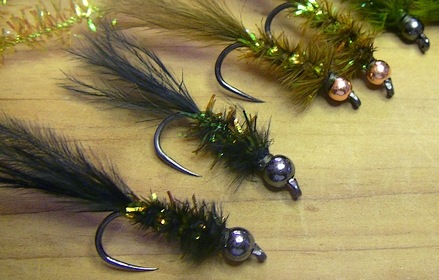
For the first time I found myself commiserating with the prey – as I alternately nursed one fingertip after another. Materials that obscure the hook point yet need to be coaxed backwards on the shank – like hackle or chenille, invariably put those precious highly-trained, coaxing fingers into Harm’s Way.
The pain starts to register after it’s a quarter inch in – giving you a hint you should stop applying pressure – but the follow-through is still enroute, so the second quarter inch is just a bonus. Once the point encounters the back of your fingernail it slows down some …
I’m thinking that a standard hook set would drive a #14 Humpy clean through the trout’s skull – and with a bend designed to keep the corpse attached – telling the warden, “I didn’t do it” will be a bit of a dance – what with the lifeless parr-marked corpse bobbing nearby.
Tying on these requires the vise to grip the bend of the shank and none of the point, or just the point and none of the bend. With a 10 degree offset, grabbing both point and bend will bend the wire, removing the kirbed portion and possibly weakening the wire.
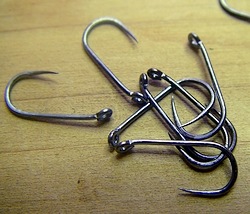 The points are fiendish, much longer and sharper than what I’m used to – and beaked, turned up to hold onto the flesh its just violated.
The points are fiendish, much longer and sharper than what I’m used to – and beaked, turned up to hold onto the flesh its just violated.
They adhere to traditional Redditch sizing – which I like much better than the Tiemco / Mustad standards. Both the Tiemco 100 series and the Mustad 94840 / 3906B are about 1X longer than they should be – and the Knapek are sized true like the older and shorter Partridge, “Captain Hamilton” style.
In short, I’m in love – not the sappy “chick flick” kind, more of the sinister sado-masochistic thing – and with piercing all the rage, I can wait till “Mr BB-Lip” finishes wowing the girls with his fourteen piercings, then I can recount the last thousand I endured …
I’m not so sure the Masai might not induct me as a full blood brother…
Ice Cream on tap and the Pizza Chopper hovering overhead
 Once again I’m the center of attention as co-workers dance about me in utter horror.
Once again I’m the center of attention as co-workers dance about me in utter horror.
We’re leaving this morning for the Annual “Guys from work go fishing and talk smack about everyone else,” trip – and I’m being admonished to bring quarters for the shower…
“Shower? %$#@ That.”
While the other fellows roll their eyes skyward pantomiming the “Eww” face, I’m wondering how we got to this sordid gentrified state.
When I backpacked we’d use a handful of wild lavender for soap and go bare-arsed into the lake – and only then after being voted off the island. Grubby clothing and a weeks worth of stubble was nothing when you’re cutting your own firewood and survival was Rainbow Trout stuffed with the last handful of trail mix.
Add eight miles of dusty trail to a week without Twinkies, sprinkle in 5000 feet of elevation and we swore Rice-A-Roni was ladled by Wolfgang Puck hisself…
Older bro’s hushed whisper, “this lake has Brown Trout!” really meant, “maybe these are imbued with different natural spices” – as we’d run out of Lemon Pepper a week ago.
Now, with pavement leading up to a groomed fire pit and a trunkload of gleaming cutlery, thousand candlepower lanterns, and Gnocchi’s boiled over a gas stove – we’re back to white dinner jackets and fine china.
“Maybe some cold cuts and a little bread to make a sandwich, we’ll have been on the water for 15 hours, horse shit will look and taste good by then. Just keep the cleanup light – as once that food hits your belly – and after all that fishing, you’ll be asleep in minutes.”
They weren’t listening. They were lost in a land of pizza choppers hovering overhead delivering cases of cold beer and thick steaks.
It dawned on me that it’s the converse that’s true – and why I find so many empty discarded water bottles in the forest. It’s not how rough it is that characterizes the outdoor experience – it’s the degree you tamed the outdoors that now separates the hardcore from the casual.
Unless you’ve got ice cream on demand, you’re not an outdoorsman, unless you transform that 30X30 regulation campsite into your living room, complete with satellite TV and NFL Ticket, you’re a total outdoor wuss.
I’ve only got a couple of choices, yank the generator cord and watch them cry over all that wasted dairy, asking each other in disbelief whether it’s safe to eat pate and gruyere with mayonnaise that’s been room temperature for the last nine hours…
“Bob? *Sniff* Christ Jesus, the Grey Poupon’s been kilt!”
… or I could just skip the shower all three days … which isn’t nearly as fatal, it only seems that way.
… um, still deciding ..
The saga of the Columbian Bounty Killers
 I’ve always assumed it’s professional disdain – why the Fish and Game is reluctant to use anglers for eradication or thinning fish populations.
I’ve always assumed it’s professional disdain – why the Fish and Game is reluctant to use anglers for eradication or thinning fish populations.
The only venture I know of; “Fistful of Pikeminnow”, and “For A Few Pikeminnow More”, suggest that the bounty program on Columbia River Pikeminnow netted 158,000 fish for 2008, with anglers pocketing nearly $1,000,000 during the fracas.
Nice lump of change for many – with nearly $500,000 dollars paid to the top 20 fishermen. That’s $25,000 each for countless days afield and a swell suntan.
It’s plain that the agencies are reluctant to go whole hog – as the jobs created by bounty-killer “infrastructure” projects would be neatly offset by the number of anglers abandoning work in favor of professional fishing – otherwise we’d see thousands of such programs nationwide.
Since 1990, more than three million northern pikeminnow have been removed through the sport reward program. As a result of these efforts, predation on juvenile salmonids is estimated to have been cut by 38 percent.
Whether you believe the numbers or not, that’s a healthy return on investment – considering the multi-million dollar fish ladders and bank restorations that achieve single digit returns.
During the same period we’ve increased our appetite for cooked salmon nearly 12% – suggesting that while we possess a certain altruistic lean, we are listening to the doctors lecture us on heart health.
The rise of the legendary angler and the skills commensurate
We always had some form of sporting literature lying around, old Field & Stream magazines or Outdoor Life that eventually would migrate enmasse to the John, where they joined “the sporting ladies” of National Geographic on their final tour before discard.
Whether it was upland game or bird hunting, there was always some story featuring a grizzled antisocial codger who had uncanny hounds, or Labrador retrievers that played outfield for a AAA club, whose noses ferreted out game via nonverbal link with master and whichever direction chaw was spat …
Duck hunters got the fellow that drank excessively, grabbed his nose, squatted, and bleated some high pitched noise via nasal resonance; “ee-bie, eenie, EE-nie” – causing birds to halt midair and dive for his blind like Stuka’s swarming Poland.
I always thought fishermen were shortchanged with all these colorful stories, we got the “snagged rubber boot” story, whose characters spoke precise English and observed semi-normal hygiene.
Some fellow living in a log cabin in West Yellowstone isn’t colorful enough, especially when he’s book-ended with wife, kids, and SUV. Relationships prove he’s mastered most of the social skills, and not the kind of hoary legend I’d pay to guide me through the woods..
Water-witching, old guys with uncanny skills, and outdoor exorcisms have been the exclusive purview of our gun-toting cousins, but all that’s changed – we’ve got our own brand of superhero …

Little red flags mark the writhing hoards of monstrous worms ready to do their master’s bidding – thousand yard stare from three tours with the LRRP’s in ‘Nam, it’s page one material, ladies …
… and if your Yellowstone guide can’t summon clouds of mayflies, you got ripped, Pilgrim.
Unlike Bell Bottoms this kind of tacky is a good thing
It was a crash course in paraffin, beeswax, petroleum distillates, herbal additives, and tropical fruit – none of which I’d anticipated with such a mundane bit of research.
I’ve gone through three sports, two industries, and a half dozen hobbies – hoping to find something special, and found that the ignoble Beeswax remains right up there with the tackiest waxes known. I found better, but the toilet ring from the local hardware store is still among the top waxes available.
As described in an earlier post, wax usage is on the decline – limited to those geezers like myself that learned prior to the debut of specialty fly tying threads and pre-waxed nylon. In those days small thread was size “A” – and most of it came from the sewing trade.
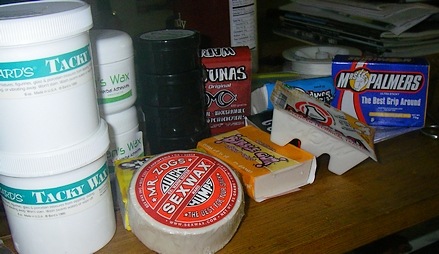
Desirable characteristics include being soft enough to use with materials other than thread, non-staining and colorless so it doesn’t change the material, non-oxidizing – so you can leave the cap off and the material doesn’t harden, and cheap as dirt – so you can indulge in obscene rituals without breaking the bank.
10 different surf board waxes and three different temperatures later, it’s safe to conclude that feet and flies don’t share any similarity. Surf wax is much harder and less tacky than Beeswax and is only a bit softer than candle wax. It has a light “tack” to the touch, is cheap – less than $2 per block, and is available with the best range of scents; Mango, Banana, Bubblegum – but no Nightcrawler or Salmon Egg, which would’ve tilted my research instantly.
While disappointing, it only whetted my appetite, knowing that somebody somewhere had a malleable wax with enough surface sticky to make fly tiers happy.
Casting and the mold making “lost wax” process uses a repair wax that’s soft and somewhat sticky, sold by the pound it fit only the malleable and cheap criteria.
40 Rivers mentioned bow wax, used to lubricate bow strings; it’s soft enough but it’s dual purpose – to adhere bow string filaments into a single strand and to lubricate the pulleys and gears used in modern compound bows. There’s many different kinds and was the sole industry distinguishing between sticky and tacky.
Bow strings (both crossbow and compound bows) are made from a diverse mix of fibers, including many synthetics like Dyneema. Some waxes use a mixture of wax and silicon, others use Beeswax blends designed for older bows. Silicon suggested even more possibilities, being the dominant component of liquid dry fly floatants and many common pastes. A fellow that ties mostly dry flies might want to yield some sticky in lieu of a wax with water resistance and minor floatation qualities.
Bow wax is worthy of additional study.
Magician’s use tacky wax for palming cards and other magic tricks. Like bows and surfboards, dozens of different varieties exist – each touted as stickier than most or stickiest. Small balls of this semi-transparent white wax are concealed in the magician’s palm, allowing him to press the hand against the deck and remove cards.
These waxes are perfect for traditional thread work, quite sticky to the touch and will enable a thread to load considerable fur without assistance. As the wax sticks to everything; human skin, paper, fur, beer cans, etc., and is colorless and odorless – it’s perfect for fly tying.
… I suspect it’s stolen from another industry however, and as additional candidates were delivered the Holy Grail became clearer…
Museum wax.
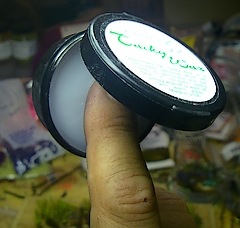 Designed to attach precious artifacts to glass display cases without staining or adding residue. Also called “Miniature Wax” – used by those hobbyists that delight in recreating the battle of Waterloo with lead soldiers, spending months building battle scenes complete with miniature foliage and regiments of soldiers, all of which is secured to the base substrate with small balls of semi-transparent white wax.
Designed to attach precious artifacts to glass display cases without staining or adding residue. Also called “Miniature Wax” – used by those hobbyists that delight in recreating the battle of Waterloo with lead soldiers, spending months building battle scenes complete with miniature foliage and regiments of soldiers, all of which is secured to the base substrate with small balls of semi-transparent white wax.
A white wax that sticks to absolutely everything …
Department 56 “Tacky Wax” was one of two finalists. Department 56 is known for miniaturized Christmas villages and provides a complete line of miniature building materials for hobbyists. Retail is $2.50 for about 1-1.5 ounces – and can be found on eBay for less than half retail. Like all eBay items it’ll be available at many prices – some more than retail, so wait for your price to appear.
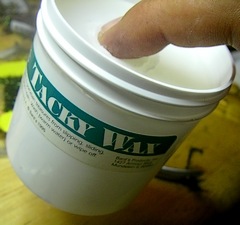 Bard’s Tacky Wax is another museum grade display wax, looks identical to the Department 56 product and is extremely tacky. It’s comparable in price to the Dept 56 product, but is also available in 6 ounce tubs for about $9.50.
Bard’s Tacky Wax is another museum grade display wax, looks identical to the Department 56 product and is extremely tacky. It’s comparable in price to the Dept 56 product, but is also available in 6 ounce tubs for about $9.50.
The picture at right shows the six ounce container suspended by the grip of the wax on my finger – plenty of tack to suit us fly tying fiends – something Beeswax was unable to reproduce …
Both are perfectly suited for fly tying. Soft and malleable allowing you to press a feather into the surface, works exceptionally well on thread (once removed from the container), and both are odorless and colorless – allowing use on white or light colored materials, and doesn’t oxidize or harden when left with the container open.
Neither are derivatives of Beeswax – as they lack the “greasy” feel at room temperature common to Overton’s and the venerable toilet ring, which are Beeswax based. Handling the wax will add “tacky” to your fingers without any apparent residue – also different than Beeswax – which adds “sticky” and visible residue.
I suspect many of the Magician’s Wax products are actually miniature wax decanted into different containers. Comforting to note that fly tying isn’t the only hobby scrounging elsewhere for materials.
I’ll decant wax from the containers and encase the ball of material in simple saran wrap, exposing half to the elements for brushing on thread, while handling the wrapped side. Simply close the wrapping around the ball when leaving on your bench so it doesn’t pick up trimmed material from the work surface.
Wax is one of those materials never made for fly tying – merely lifted from another industry and decanted into a more suitable container. Brown waxes are traditionally blends of Beeswax and other compounds, white waxes can be paraffin based or an entirely different synthetic compound.
Synthetics offer tackiness without the room temperature greasiness of Beeswax nor the slight discoloring inherent in a darker wax. If you’re dissatisfied with your current fly tying wax you might want to look into either of the above museum waxes as an alternative.
Where Elvis and the Buzzbait will reign supreme
 Steeped in controversy yet the theory is simple; if garlic and lemon makes it palatable then it escapes the invasive label. If it’s too small to barbeque it’s destined to be fought tooth and nail.
Steeped in controversy yet the theory is simple; if garlic and lemon makes it palatable then it escapes the invasive label. If it’s too small to barbeque it’s destined to be fought tooth and nail.
The exception being Rock Snot, which despite urging from the President’s Council on Physical Fitness, we avoid salad like the plague so there’s little mystery in why we’re determined to eradicate it.
The Jewel of the Sierra Nevada, Lake Tahoe, may soon dwarf anything on the B.A.S.S. circuit – what with it being the second deepest lake in the US, proximity to the glitz and glamour of Reno, and filled with defenseless fat Mackinaw, Rainbow, and Brown trout just waiting to serve as forage for the Largemouth Bass…
That new world record from Japan is on unsteady ground in light of this high elevation jewel and its gradually warming water – two degrees in the last seventy years, and projected to warm further in the next decade.
Likely introduced by anglers in the Tahoe Keys neighborhood of South Lake Tahoe in the early 1990s, bass and bluegill appear to be spreading throughout the lake slowly but steadily.
The fish have overrun the Keys and have been found in more than half of the marinas and lagoons sampled around the lake.
The current residents were all introduced by Man, with eradication of the native Lahontan Cutthroat following shortly thereafter, making the Largemouth and Bluegill introduction a “double negative” – halting efforts to restore the native fishery.
A cold water Largemouth is fine table fare – and other than the Elvis impersonator in the V-8 equipped “party barge” next to you, little will change other than the quarry.
A powerpoint presentation suggests that the shallow marinas offer warmer water – and further development near the lake shore assists the warming process, with portions of the lake warming as much as three more degrees, allowing for a longer growth season and approaching temperatures Largemouth find attractive.
If current warming trends persist – about 2070 we’ll be hosting some spectacular fishing.

